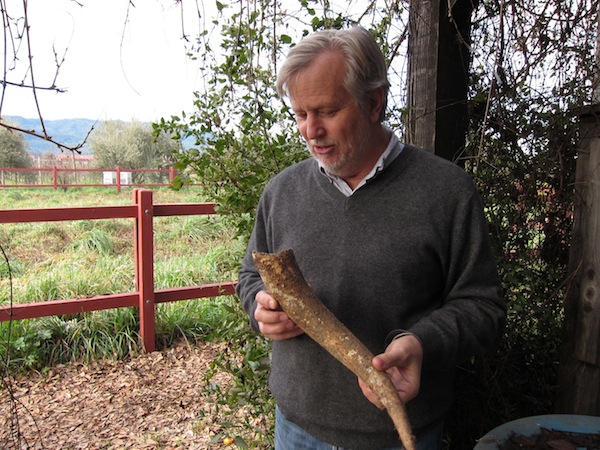Gamble Family Vineyards Sauvignon Blanc and cucumber oysters
 |
| Tom Gamble. |
The only things I feel bad about telling you about the 2007 Gamble Family Vineyards Yountville/Napa Valley Sauvignon Blanc (about $28) is that not a lot of it was made (1,650 cases), and it’s not widely distributed in the U.S.
But it’s my insensitive side (yes, even I have one) that makes me want to go on and babble about this beautifully dry white wine like a lawyer in love because, well, it’s probably the finest Sauvignon Blanc I’ve tasted in many years (those of France’s Loire River and New Zealand not excluded).
How shall I count the ways? Unlike French grown Sauvignon Blancs, to begin with, the Gamble Family is not dominated by minerality; and unlike the vast majority of New Zealand and California grown Sauvignon Blancs, it is not focused entirely on fruitiness (or weediness) either. There is, in fact, a ringingly bright and penetrating white peach quality to the qubw, playing in the nose with fresh cream, wildflower, wet stone and distinctive licorice-like fragrances.
 |
| Sauvignon musqué. |
On the palate, the citrusy characteristic of the grape is manifested in a lemony fresh dryness; combining with the peachy fruitiness, a dripping, cantaloupe-like juiciness, and creamy barrel fermented textures (71% of the wine fermented in French oak and aged on the lees – i.e., dead yeast cells – to enhance mouth-feel) to form a lush yet zesty, snappy, silky smooth texture and feel, lingering on the palate like a bad habit.
The Gamble Family properties have been CCOF certified organic since 2007; a factor having as much to do with the wine’s purity of fruit qualities as the clonal selection going into the wine (half the vineyard planted to the highly prized, powerfully aromatic Sauvignon musqué clone). Gamble is also such a meticulous farmer that grapes going into the family's ’07 Sauvignon Blanc were deliberately picked on no less than seven separate occasions; the earlier harvested fruit coming in with higher acidity, resulting in the zingy, electrical quality of the resulting wine; and the fruit harvested later in the season contributing the deep, bright, multi-faceted tropical fruit intensity.
 |
| Tom Gamble with Gamble Family Vineyards winemaker Jim Close. |
Above all, this Sauvignon Blanc speaks “of a place,” or terroir; a vineyard that has long been hitting its stride and reputation for producing pretty much picture-perfect California Sauvignon Blanc – mouth-wateringly juicy, yet crisp, refined, and true – and farmed intelligently enough to allow this to shine.
Anytime you come across such perfection of Sauvignon Blanc, there are two implicitly perfect foods that cannot possibly steer you wrong: a pure, pearly white Chèvre, or else a plate of pure, chilly, unadorned oysters. But if you want to go through some culinary motions, I think this recipe out of emerils.com for cold cucumber soup with Louisiana oysters on the half shell and osteria caviar is also as good a match for the wine’s lemony crispness and wet stony, fragrant, licorice nuanced fruitiness as anything.




Comments
Post a Comment